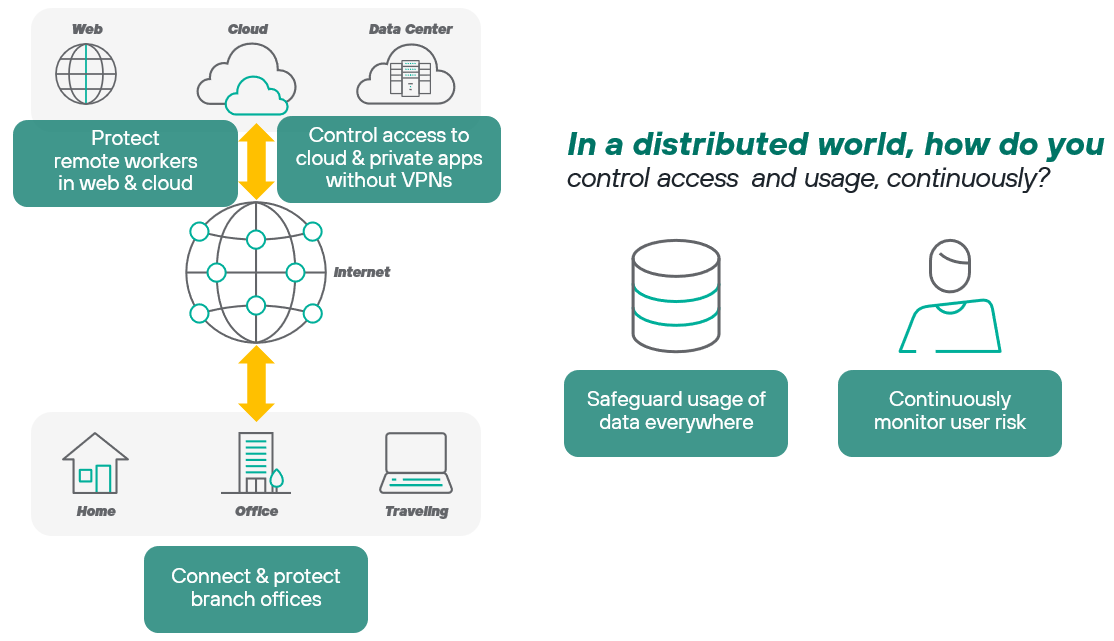É hora de adotar um novo caminho para o SASE
0 minutos de leitura

Parte de nossa série em andamento sobre Zero Trust e SASE.
Talvez você esteja lendo esta publicação do blog no notebook em casa. É possível que não tenha ido ao escritório por semanas, ou meses. Quem sabe quando você vai passar o crachá na roleta novamente? E, quando fizer isso, provavelmente ficará em um daqueles espaços de trabalho compartilhados flexíveis, em vez de um cubículo ou escritório pessoal. É a realidade de trabalhar em qualquer lugar.
Much has been written (see here or here) about the security risks of working beyond what used to be called the corporate perimeter and how enterprises might adapt. Organizations have moved faster to cloud and SaaS apps than anyone would have expected a year ago, to the point that the journey to the cloud is no longer an issue of if, but when, and not of digital transformation, but of business transformation.
With people and data moving everywhere, security has to be agile to keep up. Now, the key issue facing many organizations is how to most effectively provide safe access to corporate resources on the web, in cloud apps and in internal, private apps anywhere, while keeping data safe everywhere.
SASE has rapidly become the headliner in IT investments for enabling the new distributed workforce. However, there’s a lot of confusion about where to start that’s made worse by vendors who are simply using the term “SASE” for re-badged point products. Of course, most SASE solutions are cloud-delivered. They also tend to be access-centric, that is, focused on controlling and protecting access to those corporate resources.
The whole point of access is to connect people to data so that they can use it to get their jobs done. A lot of vendors view that as the finish line. It’s not. To put it bluntly, securing access is just table stakes these days.
Enabling data to be used safely is ultimately what cybersecurity is all about. With people working anywhere, you can no longer rely upon old approaches such as trusting that their laptop or a device is attached to your ‘corporate’ network to have free reign with sensitive data. You have to control how that data is used—continuously requiring explicit permission every time somebody tries to access or move that data.
 This ‘requiring explicit permission’ is the essence of Zero Trust. How do you apply Zero Trust? It turns out that SASE is answer. SASE brings together the wide range of capabilities for implementing Zero Trust into a converged, cloud-based platform that easier to deploy and manage than prior approaches.
This ‘requiring explicit permission’ is the essence of Zero Trust. How do you apply Zero Trust? It turns out that SASE is answer. SASE brings together the wide range of capabilities for implementing Zero Trust into a converged, cloud-based platform that easier to deploy and manage than prior approaches.
In our new whitepaper “5 Steps to SASE,” we can help organizations start on their path to what we’re calling a data-centric SASE architecture. It covers:
- How security teams and leaders can begin from different starting points to build out their converged SASE architecture, one cloud-delivered capability at a time.
- A definition of data-centric SASE and how protecting users and data is different from a SASE approach focused solely on access.
- The benefits and capabilities of data-centric SASE, which includes data protection, threat protection, application security and network security.
- We list the top 4 advantages that you should look for in a data-centric SASE platform.
We hope you find this paper useful to sorting out your priorities for protecting users and safeguarding critical information. Click the green Read the Whitepaper button to the right to download it.
- 5 Steps to SASE - Your Executive's GuideRead the Whitepaper
X-Labs
Receba insights, análises e notícias em sua caixa de entrada

Ao Ponto
Cibersegurança
Um podcast que cobre as últimas tendências e tópicos no mundo da cibersegurança
Ouça Agora








